How Many Amps Does a Computer Use?
ZacharyWilliamIf you are planning a home office, sizing a circuit, or wondering whether a portable power station can safely run your PC, the key number you need is amps. This guide walks through real-world amp ranges for laptops and desktops in a typical U.S. home (120V power), plus how to calculate your own setup.

- Laptops: usually about 0.5–1.5 amps while charging.
- Office desktop + monitor: about 1–3 amps while working.
- Gaming / creator desktop + monitor: around 3–8 amps at full load.
The exact number depends on your hardware (CPU, GPU, monitor), how hard it is working, and how efficient the power supply is.
Amps vs. Watts vs. Volts (Quick Basics)

In the U.S., most household outlets provide about 120 volts (V). Your computer uses a certain amount of power measured in watts (W), and that translates into current measured in amps (A).
The relationship is: Amps = Watts ÷ Volts
- If your PC uses 240 watts at the wall, at 120V that’s about 2 amps (240 ÷ 120 = 2).
- If it spikes to 600 watts while gaming, that’s about 5 amps (600 ÷ 120 = 5).
Most labels on power supplies and monitors list watts, not amps, so it’s normal to calculate amps from watts using this simple formula.
Typical Amp Draw for Common Computer Setups

Below are ballpark ranges for typical modern systems under normal use (web, office work, light creative work) with occasional peaks when the CPU or GPU is fully loaded.
| Computer Type | Typical Power at Wall (W) | Approx. Amps @ 120V | Notes |
|---|---|---|---|
| 13–15" Ultrabook laptop | 30–65 W while charging | ≈ 0.3–0.6 A | Light office use, integrated graphics. |
| 15–17" mainstream laptop | 65–100 W | ≈ 0.6–0.9 A | Heavier multitasking, some light gaming. |
| Mini PC / small desktop | 30–100 W | ≈ 0.3–0.8 A | Compact systems, basic graphics. |
| Office desktop + 24" monitor | 150–300 W | ≈ 1.3–2.5 A | Balanced CPU, no high-end GPU. |
| Gaming / creator PC + 1–2 monitors | 300–600 W (typical while gaming) | ≈ 2.5–5 A | Mid-range CPU + GPU, typical gaming/3D workloads. |
| High-end gaming or workstation rig | 600–1000 W+ (peak) | ≈ 5–8.5 A | Top-tier GPUs, many drives, heavy rendering or AI workloads. |
What Changes How Many Amps a Computer Uses?

Two identical computers can draw different amps depending on how they’re used. Major factors include:
1. CPU and GPU load
Gaming, 3D rendering, and video encoding push both CPU and GPU toward their limits. Web browsing or writing documents keeps them mostly idle, which cuts amp draw dramatically.
2. Graphics card and resolution
High-end graphics cards and 4K gaming can easily double the power usage compared with integrated graphics or low-end GPUs. More pixels and higher refresh rates require more work per frame.
3. Number and size of monitors
Each monitor has its own power draw:
- Typical 24" office monitor: roughly 20–40 W (≈0.2–0.3 A).
- Larger, brighter, or high-refresh gaming displays may use 50–100 W or more.
4. Peripherals and USB devices
External hard drives, speakers, RGB accessories, webcams, and USB-powered devices all add a bit of extra wattage, which shows up as more amps at the wall.
5. Power supply efficiency
A more efficient power supply wastes less energy as heat. An 80 PLUS Gold or Platinum PSU will draw fewer watts from the wall for the same internal load than a low-efficiency supply, shaving the required amps.
6. Power settings and brightness
On laptops, screen brightness and power profiles (Balanced, Performance, Battery Saver) have a big impact. On desktops, enabling power-saving settings and letting the monitor sleep can noticeably reduce average draw.
How to Calculate Your Own Computer’s Amp Draw

Step 1: Find wattage from the label or adapter
- Laptops: check the AC adapter (the “brick”). Look for something like “Output: 20V 4.5A” or a watt rating such as 65W, 90W, or 130W.
- Desktops: the power supply unit (PSU) has a rated wattage (e.g., 500W, 750W). This is the maximum it can deliver, not what it always uses.
- Monitors & accessories: many have a label on the back showing watts or amps.
Step 2: Estimate real usage
For desktops, a reasonable rule of thumb is:
- Light office use: roughly 30–40% of PSU rating.
- Gaming or heavy workloads: often 50–70% of PSU rating, with occasional short spikes higher.
For example, a 650W gaming PC might average 350–450W while gaming.
Step 3: Convert watts to amps
Use the formula: Amps = Watts ÷ Volts
- Example: 240W office PC on 120V → 240 ÷ 120 = 2 amps.
- Example: 450W gaming load on 120V → 450 ÷ 120 ≈ 3.75 amps.
Step 4 (Best): Measure with a plug-in power meter
For the most accurate number, you can plug your PC and monitor into an inexpensive plug-in power meter. It will display live watts, which you can convert to amps with the same formula.
Computers on 15A and 20A Circuits
In many U.S. homes, standard circuits are rated at 15 amps, and some dedicated outlets (like those in offices or workshops) are 20 amps.
- 15A × 120V = 1800W maximum.
- 20A × 120V = 2400W maximum.
Electricians usually recommend staying under about 80% of the circuit rating for continuous loads:
- 15A circuit: about 1440W of continuous load.
- 20A circuit: about 1920W of continuous load.
That means even a fairly power-hungry gaming computer using 600–800W has room to spare on a dedicated 15A circuit, as long as you are not also running space heaters, laser printers, or other heavy appliances on the same line.
Using Portable Power Stations or Solar Generators
When you use a computer with a portable power station or solar generator, you still care about amps at the AC outlet, but the product specs are usually listed in watts (W) and watt-hours (Wh).
1. Matching inverter watts to your computer’s load
The power station’s AC inverter must comfortably exceed your computer’s peak wattage:
- Laptops and small desktops: often fine on a 200–400W portable power station.
- Mid-range desktop or modest gaming PC: look for around 600W of continuous AC output.
- High-end gaming rigs or multiple devices: 1000W+ (with a healthy surge rating) is safer.
- UDPOWER C400 (about 256Wh, 400W continuous output, 4,000+ cycle LiFePO₄ battery) is well-suited to laptops, mini PCs, and low-power desktops during short outages or camping use.
- UDPOWER C600 (596Wh capacity, 600W output, peak 1200W) can comfortably handle a typical office desktop and monitor, or a laptop plus extra peripherals, with quiet, clean power.
- UDPOWER S1200 (around 1,190Wh capacity, 1,200W inverter, up to 1,800W surge, LiFePO₄ battery with 4,000+ cycles) offers enough headroom for gaming PCs, multiple monitors, and networking gear, plus an ultra-fast UPS-style switchover time designed to keep sensitive electronics running during grid glitches.
If you want to explore options, you can compare these models directly on the UDPOWER portable power station collection page .
2. Estimating runtime from watt-hours
To estimate runtime, use: Runtime (hours) ≈ (Battery Wh × 0.8–0.9) ÷ Load watts
- Example: a desktop and monitor drawing about 300W on a 596Wh unit like the C600 might run roughly 1.5–1.75 hours between charges under steady load.
- The same C600 running a 60W laptop could provide around 8 hours or more, depending on screen brightness and workload.
- A larger unit such as the S1200 (≈1,190Wh) could keep a 300W office setup running for around 3–3.5 hours in many real-world scenarios.
These are estimates; actual runtime depends on power station efficiency, temperature, and how spiky your computer’s workload is.
Safety Tips for Managing Computer Power Use
- Avoid overloaded power strips: don’t share a strip with heaters, microwaves, or other high-draw devices.
- Use quality surge protection: a good surge protector or UPS can protect your PC from voltage spikes and brief brownouts.
- Give equipment room to breathe: high amp draw means more heat. Keep vents clear so your PC and power supplies stay cool.
- Stay within circuit limits: if lights dim or breakers trip when you power on your PC plus other gear, redistribute the load.
- For portable power stations: follow the manufacturer’s directions, use only recommended charging cables, and keep ventilation openings unobstructed.
FAQ: Common Questions About Computer Amps
How many amps does a laptop use?
Most modern laptops use between 0.5 and 1.5 amps at 120V while charging, depending on size and workload. Ultrabooks with 45–65W adapters are near the low end, while high-performance or gaming laptops with 100W+ adapters are near the upper end.
How many amps does a gaming PC use?
A typical mid-range gaming PC with one graphics card and a couple of monitors often pulls around 3–5 amps while gaming. High-end systems with powerful GPUs, many drives, and overclocked CPUs can momentarily reach 6–8 amps or more.
Is a 15A circuit enough for a gaming computer?
Yes, a single gaming PC setup is usually fine on a 15A circuit, as long as you are not also running other large loads (space heaters, window AC units, etc.) on the same circuit. Most gaming systems stay well under 1000W (about 8.5A at 120V) even at peak.
Do monitors and accessories add much to the amp draw?
Each monitor typically adds 20–100W (0.2–0.8A), depending on size and brightness. Speakers, USB devices, and external drives usually add much smaller amounts individually, but together they can add 20–50W or more to the total load.
Does using 240V instead of 120V change how many amps my computer uses?
The computer’s power in watts is essentially the same, but at 240V it will draw about half the amps compared with 120V (because amps = watts ÷ volts). In typical U.S. homes, computers are almost always plugged into 120V outlets, so the amp numbers discussed in this article assume 120V.
Is a portable power station safe for desktop computers?
A high-quality portable power station with a pure sine wave inverter and sufficient wattage is generally safe for desktops and monitors. Models that are specifically designed for sensitive electronics and offer fast UPS-style switchover times are especially helpful if you want protection during outages or grid flicker.


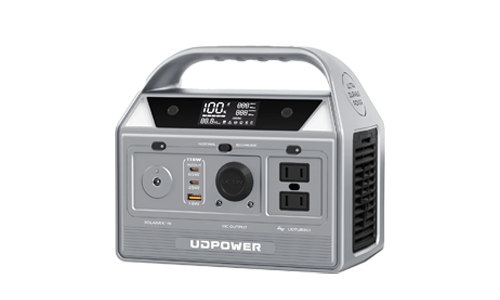
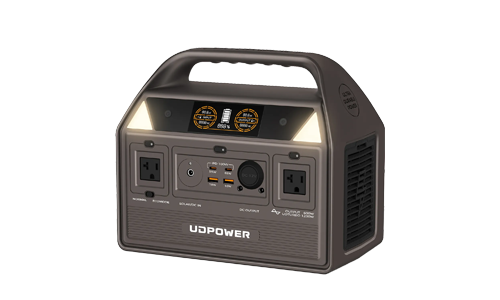
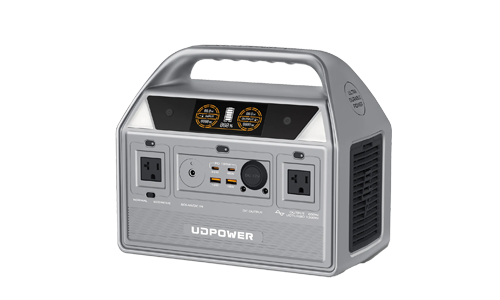


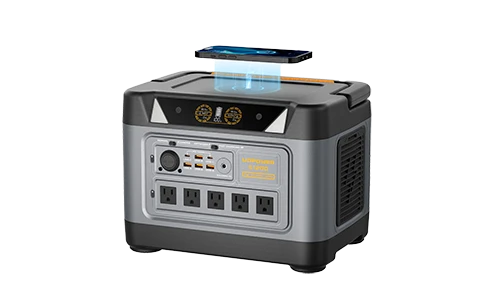



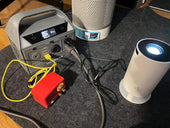
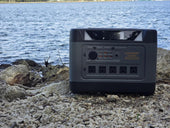
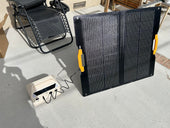
















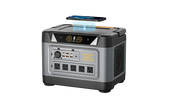



















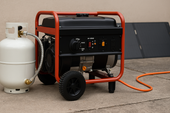

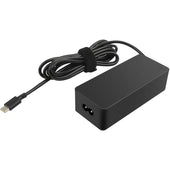

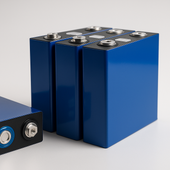









![How to Live In The Woods [Complete Guide]](http://udpwr.com/cdn/shop/articles/Off-Grid_Cabin_Option_f6c94fe7-1ae7-4c3a-baf5-ed9fe684c832.png?v=1763523215&width=170)




